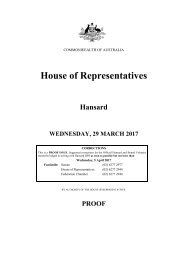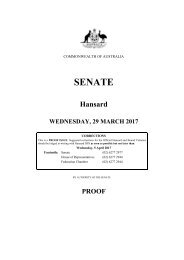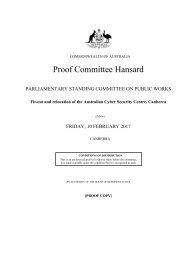SENATE
2mKfSKX
2mKfSKX
Create successful ePaper yourself
Turn your PDF publications into a flip-book with our unique Google optimized e-Paper software.
Wednesday, 1 March 2017 Senate Page 11<br />
Air Chief Marshal Binskin: They are classic Hornets at the moment. As you know, we are approved to<br />
deploy up to 8 Hornets, whether they be super or classic. Currently they are classic. We normally have six in<br />
country for operations in the base in the Middle East we operate from. At the moment, temporarily for a couple of<br />
months, we have a seventh aeroplane in theatre. This is predominantly from an administrative point of view. We<br />
are across doing an exercise with one of the countries in the Middle East. This is part of our normal exercises. At<br />
the time we were doing what we call a 'tail swap' of aircraft. About every six to eight weeks we will swap a<br />
couple of aeroplanes out to bring them back for a deep level maintenance back in Australia. As part of that tail<br />
swap, we did an exercise in country. To reduce the number of tail swaps we do, we left an extra aircraft in there<br />
for a period of a couple of months. The rate of effort has gone up a little bit in support of Mosul. We could have<br />
done that with the six aeroplanes. The seventh just makes it easier for the maintainers and takes an administrative<br />
costs from one of the swap outs away.<br />
Senator FARRELL: I think you mentioned how many times we have flown, but I'm not sure you have<br />
distinguished between Iraq and Syria. Would you be able to give us that information?<br />
Air Chief Marshal Binskin: You are more after the FA18s, I would imagine.<br />
Senator FARRELL: Yes, I am.<br />
Air Chief Marshal Binskin: The Super Hornets flew 418 sorties in total. That was all in Iraq. The classic<br />
Hornets have flown 1,749 sorties in total, of which 48 have been in Syria.<br />
Senator FARRELL: On average, how many missions are we flying daily or weekly and on how many<br />
occasions have our pilots fired their weapons?<br />
Air Chief Marshal Binskin: I will not get into the daily rate of effort, but I am happy to talk in camera a bit<br />
more about what the rate of effort is. The super Hornets employed 278 weapons during that time, and they were<br />
the first rotation through. The classic Hornets have dropped 1,425 precision weapons in total, of which 67 have<br />
been in Syria.<br />
Senator FARRELL: Have any RAAF asset been fired upon while undertaking operations since the last<br />
estimates?<br />
Air Chief Marshal Binskin: I have not had any reports of them being fired on, but that does not mean that it<br />
has not happened. Although they do operate in an environment that is well clear of the predominant number of<br />
weapons systems that are in Iraq and Syria. That doesn't mean a soldier hasn't picked up a gun and shot something<br />
at them. But the chances of that doing anything is quite slim—touch wood.<br />
Senator FARRELL: Can you tell us how our contribution to the war effort is compared to the other<br />
participants?<br />
Air Chief Marshal Binskin: The Australian contribution is a substantial contribution. You can talk about<br />
whether it is the second-largest after the US in the coalition in Iraq. It is difficult to compare because some<br />
nations are doing something on the ground, others are doing it in the air. But when you look at the combination of<br />
what we are doing with our task group, we have the strike aircraft, the tanker, the Wedgetail airborne early<br />
warning and control aircraft and the building partner capacity at Taji, which is about 300 Australians. You can<br />
also look at the 50 or so embeds we have in coalition headquarters and the special operations task group that sits<br />
around about 80. You do that combined air and land and it is a substantial contribution. And it is a valued<br />
contribution for Iraq.<br />
Senator FARRELL: Obviously the United States is doing most of the work. How do we compare with the<br />
other countries around our size in terms of contribution?<br />
Air Chief Marshal Binskin: If you look at our deployment compared to other countries that are involved, I<br />
would say that we are pretty much to the top of the coalition. It would depend. For example, if the French had an<br />
aircraft carrier in, that would increase their contribution. When the aircraft carrier is not in it reduces their<br />
contribution. But consistently, I would say we have been probably close to leading the other coalition nations in<br />
just size and what we are doing with our force.<br />
Senator FARRELL: Is that recognised by those other countries?<br />
Air Chief Marshal Binskin: Yes, it is.<br />
Senator Payne: And by the government of Iraq, Senator. Most definitely. There are 34 or 35 countries who<br />
participate in the large minister’s meeting of the counter ISIL coalition, the most recent meeting of which was<br />
held at NATO headquarters in Brussels about 10 days ago, which I attended. In the small ministerial group there<br />
are about 12 members—that is, 12 of the larger contributors. In the past months, each iteration of the counter ISIL<br />
meeting has seen an increase in the numbers participating. And new ministers, and therefore new countries,<br />
FOREIGN AFFAIRS, DEFENCE AND TRADE LEGISLATION COMMITTEE















